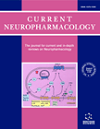- Home
- A-Z Publications
- Current Neuropharmacology
- Previous Issues
- Volume 14, Issue 7, 2016
Current Neuropharmacology - Volume 14, Issue 7, 2016
Volume 14, Issue 7, 2016
-
-
Stress, the Autonomic Nervous System, and the Immune-kynurenine Pathway in the Etiology of Depression
More LessAuthors: Eunsoo Won and Yong-Ku KimThe autonomic nervous system is one of the major neural pathways activated by stress. In situations that are often associated with chronic stress, such as major depressive disorder, the sympathetic nervous system can be continuously activated without the normal counteraction of the parasympathetic nervous system. As a result, the immune system can be activated with increased levels of proinflammatory cytokines. Read More
-
-
-
Inflammation and Immune Regulation as Potential Drug Targets in Antidepressant Treatment
More LessAuthors: Frank M. Schmidt, Kenneth C. Kirkby and Nicole LichtblauGrowing evidence supports a mutual relationship between inflammation and major depression. A variety of mechanisms are outlined, indicating how inflammation may be involved in the pathogenesis, course and treatment of major depression. In particular, this review addresses 1) inflammatory cytokines as markers of depression and potential predictors of treatment response, 2) findings that cytokines interact with Read More
-
-
-
Animal Models of Maternal Immune Activation in Depression Research
More LessAuthors: Marianne Ronovsky, Stefanie Berger, Barbara Molz, Angelika Berger and Daniela D. PollakBackground: Depression and schizophrenia are debilitating mental illnesses with significant socio-economic impact. The high degree of comorbidity between the two disorders, and shared symptoms and risk factors, suggest partly common pathogenic mechanisms. Supported by human and animal studies, maternal immune activation (MIA) has been intimately associated with the development of schizophrenia. However, the l Read More
-
-
-
A Potential Contribution of Chemokine Network Dysfunction to the Depressive Disorders
More LessIn spite of many years of research, the pathomechanism of depression has not yet been elucidated. Among many hypotheses, the immune theory has generated a substantial interest. Up till now, it has been thought that depression is accompanied by the activation of inflammatory response and increase in pro-inflammatory cytokine levels. However, recently this view has become controversial, mainly due to the family of sm Read More
-
-
-
Brain-derived Neurotrophic Factor (BDNF)-TrkB Signaling in Inflammation-related Depression and Potential Therapeutic Targets
More LessAuthors: Ji-chun Zhang, Wei Yao and Kenji HashimotoDepression is the most prevalent and among the most debilitating of psychiatric disorders. The precise neurobiology of this illness is unknown. Several lines of evidence suggest that peripheral and central inflammation plays a role in depressive symptoms, and that anti-inflammatory drugs can improve depressive symptoms in patients with inflammation-related depression. Signaling via brain-derived neurotrophic factor (BD Read More
-
-
-
Inflammation in Depression and the Potential for Anti-Inflammatory Treatment
More LessAuthors: Ole Kohler, Jesper Krogh, Ole Mors and Michael Eriksen BenrosAccumulating evidence supports an association between depression and inflammatory processes, a connection that seems to be bidirectional. Clinical trials have indicated antidepressant treatment effects for anti-inflammatory agents, both as add-on treatment and as monotherapy. In particular, nonsteroidal anti-inflammatory drugs (NSAIDs) and cytokine-inhibitors have shown antidepressant treatment effects compare Read More
-
-
-
Interferon-Related Depression: A Primer on Mechanisms, Treatment, and Prevention of a Common Clinical Problem
More LessAuthors: Ekta Franscina Pinto and Chittaranjan AndradeBackground: Depression is among the commonest of psychiatric disorders, and inflammatory mechanisms have been suggested to play a role in its pathophysiology. Interferons are a superfamily of proinflammatory cytokines that play a role in host defence mechanisms. Interferons are used in the treatment of a variety of autoimmune (e.g. multiple sclerosis), viral (e.g. chronic hepatitis B and C), and malignant (e.g. malignant m Read More
-
-
-
Systems Genomics Support for Immune and Inflammation Hypothesis of Depression
More LessBy Abhay SharmaBackground: Immune system plays an important role in brain development and function. With the discovery of increased circulating inflammatory cytokine levels in depression over two decades ago, evidence implicating immune system alterations in the disease has increasingly accumulated. Objective: To assess the underlying etiology and pathophysiology, a brief overview of the hypothesis free genomic, transcriptomic and pr Read More
-
-
-
Gap Junction Blockers: An Overview of their Effects on Induced Seizures in Animal Models
More LessAuthors: Joaquín Manjarrez-Marmolejo and Javier Franco-PérezBackground: Gap junctions are clusters of intercellular channels allowing the bidirectional pass of ions directly into the cytoplasm of adjacent cells. Electrical coupling mediated by gap junctions plays a role in the generation of highly synchronized electrical activity. The hypersynchronous neuronal activity is a distinctive characteristic of convulsive events. Therefore, it has been postulated that enhanced gap junctional com Read More
-
-
-
Multiple Non-Equivalent Interfaces Mediate Direct Activation of GABAA Receptors by Propofol
More LessBackground: Propofol is a sedative agent that at clinical concentrations acts by allosterically activating or potentiating the γ-aminobutyric acid type A (GABAA) receptor. Mutational, modeling, and photolabeling studies with propofol and its analogues have identified potential interaction sites in the transmembrane domain of the receptor. At the "+" of the β subunit, in the β-α interface, meta-azipropofol labels the M286 residue in th Read More
-
Volumes & issues
-
Volume 23 (2025)
-
Volume 22 (2024)
-
Volume 21 (2023)
-
Volume 20 (2022)
-
Volume 19 (2021)
-
Volume 18 (2020)
-
Volume 17 (2019)
-
Volume 16 (2018)
-
Volume 15 (2017)
-
Volume 14 (2016)
-
Volume 13 (2015)
-
Volume 12 (2014)
-
Volume 11 (2013)
-
Volume 10 (2012)
-
Volume 9 (2011)
-
Volume 8 (2010)
-
Volume 7 (2009)
-
Volume 6 (2008)
-
Volume 5 (2007)
-
Volume 4 (2006)
-
Volume 3 (2005)
-
Volume 2 (2004)
-
Volume 1 (2003)
Most Read This Month
Article
content/journals/cn
Journal
10
5
false
en


